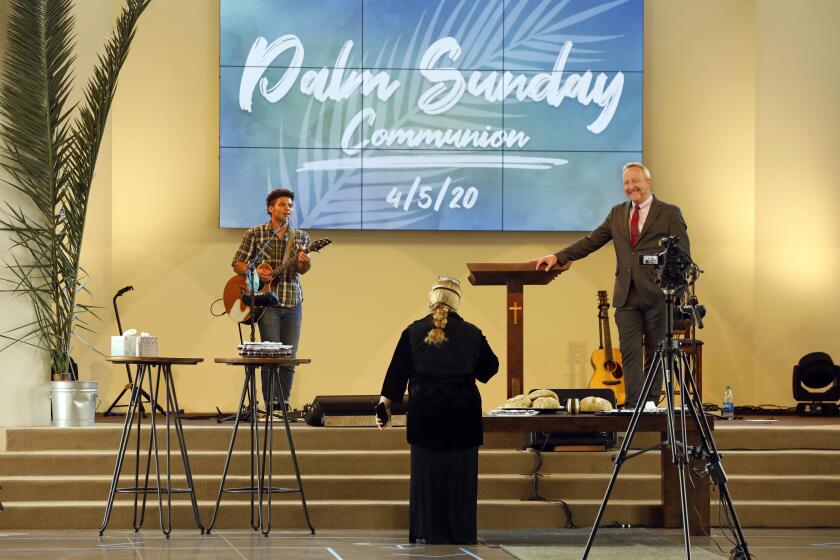San Ysidro plan envisions a revitalized border town with more housing, businesses and visitor-oriented ‘village’
San Ysidro would be transformed into a vibrant commercial and residential area under a new city plan that envisions multi-story housing along the trolley line and a tourist-oriented “village” near the international border.
The new San Ysidro Community Plan, approved in November, rezones hundreds of acres to attract new businesses and jobs, calls for more parks and sets the fees the city will charge developers to pay for dozens of badly needed infrastructure projects.
City officials and community leaders say the plan, a blueprint for development over the next 30 years, could help San Ysidro shed its image as a low-income area lacking quality housing and jobs.
The number of housing units in San Ysidro would increase by more than 31% , from 7,510 to 9,850, with many of those in multi-story condominiums and apartments built along the trolley line.
That’s known as transit-oriented development or “smart growth,” where the city seeks to address its housing shortage without creating the traffic congestion and environmental damage that typically comes with projects in more rural areas relatively far from transit and freeways.
In addition, the new plan would allow mixed-use development — typically housing built above ground-floor businesses — for the first time in San Ysidro.
Many communities in the city, especially those near the beach or in suburban areas, fight plans to add more density based on concerns about traffic and lower quality of life.
But San Ysidro community leaders, following the lead of San Diego neighborhoods of Little Italy and Grantville, are embracing the growth and increased density as a way to bolster a community with unusual challenges.
More than 32% of San Ysidro’s 29,000 residents are under age 18, the number of residents living in each household is nearly double the city average, and 18% of the community’s housing units are in subsidized complexes with income restrictions.
Meanwhile, San Ysidro features three freeways — California 905 and Interstates 5 and 805 — and development patterns that have been skewed by the presence of one of the world’s busiest border crossings.
To overcome those challenges, the new community plan focuses on the trolley line, particularly the Beyer Boulevard Station one stop north of the border.
The plan combines that part of the community with the “old town” area of San Ysidro Boulevard to create a 124-acre San Ysidro Historic Village that is intended to become the heart of the revitalization.
In addition, the plan envisions a “Mexican Village” along East San Ysidro Boulevard and Border Village Road that would become a visitor destination featuring restaurants, performance spaces and a theater.
Regarding the border, the plan has the city mostly taking a back seat to county, state and federal agencies, which are in the middle of transforming the area with additional travel lanes and a planned transportation center.
The zoning changes proposed along the trolley will allow relatively intense commercial and residential development there, which fits with the city’s climate action plan.
The San Ysidro plan also calls for new bicycle lanes and pedestrian improvements to encourage people to stop commuting by car.
With the changes proposed in the plan, the number of people in San Ysidro commuting by car would decrease from just over 88% to less than 70% , city projections show.
The corresponding increases in other commuting options would be from 8% to 13% by transit, from 3% to 7% by walking and from less than 1% to nearly 11% by cycling.
Those numbers fall well short of the goals in the city’s ambitious climate action plan, which was approved a year ago. That calls for 50% commuting by car, 25% by transit, 18% by cycling and 7% by walking.
“San Ysidro is one of the most glaringly weak community plans, but I kind of give San Ysidro a bit of a pass because it’s out of the urban core,” Nicole Capretz, executive director of the Climate Action Campaign said.
But she said allowing such communities to fall below the citywide climate targets simply shifts the burden.
“If San Ysidro and Scripps Ranch and Rancho Bernardo are not going to ever hit the 50% target that’s OK, but that means these Mid-City communities need to do more,” Capretz said. “They need to be under 50% to average out the 69% of San Ysidro.”
The problem, she said, is that San Diego officials haven’t conducted a citywide analysis to determine how much density each community can absorb, which helps determine how much it can shift commuting habits.
“The city should do an entire analysis and let communities know what they should be aiming for,” Capretz said. “They should be starting with the outcome that they want and working backwards. Right now they are literally just kind of flying blind.”
City officials haven’t embraced Capretz’s request for a comprehensive citywide analysis, but they have agreed to evaluate each new community plan after five years to gauge progress on climate goals.
The new community plan replaces one dating back to 1990. Because about one-third of San Ysidro is in the state’s “coastal zone,” changes affecting that part of the community won’t take effect until they’re approved by the California Coastal Commission.
Jeff Murphy, the city’s planning director, said last month that most of the plan’s key elements don’t need Coastal Commission approval because the parts of San Ysidro in the coastal zone are mostly open space west of Interstate 5.
david.garrick@sduniontribune.com
Garrick writes for the San Diego Union-Tribune.
More to Read
Sign up for Essential California
The most important California stories and recommendations in your inbox every morning.
You may occasionally receive promotional content from the Los Angeles Times.










